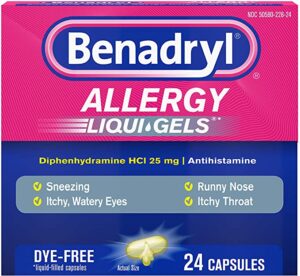
Key points
- Allergic conjunctivitis is a medical condition associated with red eyes and itchiness. It is usually caused by environmental triggers such as tree and grass pollen, mold and mildew, certain fabrics and materials, dust and dust mites, fleas, dander, hair, and feathers, cologne and perfume, household cleaning products, and certain medications.
- The symptoms of allergic conjunctivitis are usually minor and include squinting of the affected eye, excessive tear production, discharge coming from one or both eyes, and pawing at the face.
- The treatment for dog eye allergies includes sterile saline eye drops, steroid eye drops, or Benadryl. You can also use VitaminA oil as a natural remedy for canine allergies.
If your dog has red eyes and you’re wondering what is causing it – you came across the right article. While dog allergies are most commonly expressed via symptoms related to the pet’s skin or intestinal tract, they can also result in red eyes and clean eye discharge.
Red eyes, or, in medical terms, “allergic conjunctivitis,” is an eye inflammation condition that occurs due to a reaction to environmental factors such as pollen and mold. Dogs that suffer from allergic dermatitis are more prone to allergic conjunctivitis than dogs with no allergy history.
If you suspect that your dog may be suffering from allergic conjunctivitis, you should have your dog examined by a veterinarian to rule out the possibility of other more serious diseases that have the same symptoms.
If the redness is caused by allergies, this article will tell you all you need to know about dog eye allergies, their treatment, and remedies.
Table of Contents
What Causes Dog Eye Allergies?
Eye allergies in dogs are caused by different environmental factors. These factors include tree and grass pollen, mold and mildew, certain fabrics and materials, dust and dust mites, fleas, cigarette smoke, dander, hair, feathers, cologne and perfume, household cleaning products, and certain medications, such as insecticidal shampoo and flea treatment products.
Allergic reactions don’t always occur immediately, so it can be hard to find out their cause. You may need to get veterinary help to figure out the cause of your dog’s allergies.
Dog Eye Allergy Symptoms
If your dog suffers from allergic conjunctivitis, it will usually display mild symptoms that can easily be alleviated once the underlying cause is determined. The most distinct sign of allergic conjunctivitis is redness in both eyes. Other symptoms may include:
- Squinting of the affected eye;
- Excessive tear production;
- Discharge coming from one or both eyes;
- Pawing at the face.
Canine eye discharge should be clear and watery, but if it’s colored or milky, it can indicate an infection or more severe eye problems.
Can Dogs Be Predisposed To Eye Allergies?
 Dogs with itchy skin are more likely to develop allergic conjunctivitis than other dogs, so when you bring your dog to a veterinarian for a consultation, don’t forget to mention whether your pet has any history of skin itching.
Dogs with itchy skin are more likely to develop allergic conjunctivitis than other dogs, so when you bring your dog to a veterinarian for a consultation, don’t forget to mention whether your pet has any history of skin itching.
Allergic conjunctivitis is more likely to occur in dogs under 3 years of age. This condition can affect all dog breeds, but the following breeds are more predisposed to it:
- Cocker Spaniel
- Boxer
- French Bulldog
- Golden Retriever
- German Shepherd
- Labrador Retriever
- West Highland White Terrier
- Poodle
How Are Dog Eye Allergies Diagnosed?
To diagnose canine eye allergies, veterinarians will usually run a conjunctival cytology test, which reveals the presence of inflammatory cells in the eye discharge. If these cells are present, it confirms that the dog has allergic conjunctivitis. However, if the test doesn’t show any inflammatory cells, the specialist will use the elimination method to further attempt to diagnose the condition.
The next steps for your dog’s veterinarian will include performing skin allergy testing and blood tests to rule out the possibility of other diseases that have similar symptoms. These diseases include dry eye, eye infections, or corneal ulcers. Things like your dog’s breed, age, and history of itchy skin will help to determine the correct diagnosis as well.
In very rare cases, the vet may order a biopsy of the conjunctival tissue around the eyes to ensure a precise diagnosis. This procedure is performed under general anesthesia.
Conjunctival provocation test is a quick method of diagnosing allergic conjunctivitis, but unfortunately, it’s not widely available. In addition, this test has to be performed by a veterinary dermatologist rather than a general practice veterinarian.
Dog Eye Allergy Treatment
Sterile Saline Eye Drops
If the allergy is mild, cleansing your dog’s eyes once or twice a day with sterile saline may help to remove the allergen and alleviate its condition. Do not use contact lens solution for this procedure and stick to sterile saline.
Steroid Eye Drops
While human eye allergies are usually treated with antihistamines, it’s impossible to predict how canines will respond to this treatment. That’s why steroid eye drops are commonly prescribed to treat allergic conjunctivitis in dogs instead.
Remember that you should never start treating your dog with steroid eye drops without a veterinarian’s permission and prescription. This is because steroids can be potentially harmful to dogs with other eye diseases that manifest through similar symptoms.
If the allergy is acute, the vet will likely prescribe oral medications in addition to eye drops.
Diphenhydramine (Benadryl)

Diphenhydramine is an antihistamine that is highly effective and commonly used in treating allergies in both dogs and humans. Allergy symptoms such as itchy and watery eyes are a result of histamine overproduction in the body. Benadryl reduces the effects of histamines and alleviates the allergy symptoms and discomfort associated with the condition.
The recommended dosage of Benadryl for dogs is 1 mg per pound of body weight. You should start seeing an improvement in the condition a week or two after starting treatment.
However, as always, you have to consult with your dog’s veterinarian before purchasing Benadryl to make sure you choose a safe brand and ensure that there aren’t underlying factors that can make this drug dangerous for your dog.
VitaminA As A Natural Allergy Treatment
Allergy symptoms generally do not pose a threat to your dog’s life, but they can cause a lot of discomfort. If you are looking for a natural remedy for eye allergies, natural VitaminA supplements are an excellent solution.
VitaminA interacts with your dog’s endocannabinoid system, which regulates many body functions, including response to allergens. VitaminA oil has minimal to no side effects, which makes it superior to many conventional medications.
Other Remedies For Dog Eye Allergies
Canine eye allergy treatment will not only include medications but also require you to make certain lifestyle changes and take preventive measures. The only way to prevent eye allergies from occurring in the future is to help your dog avoid the allergen. Here are a few tips on how to do that:
- Remove everything that may contain the allergen from your household.
- If you suspect dust, mold, dander, or feathers to cause your dog’s allergy, try to remove as many sources of the substance as possible and keep your house clean.
- If possible, remove all carpets and soft furnishings from your home. Alternatively, you can deep-clean all soft furnishings and regularly wash your dog’s blankets and crate.
- If your dog is allergic to pollen, look up pollen counts online every day and only take your dog for walks when the pollen count is low.
- Get an air purifier to reduce the concentration of airborne allergens in your home.
- Gently cleaning your dog’s eyes with lukewarm water will help remove allergens and debris and soothe your dog’s sore eyes. Make sure to boil the water first and let it cool to room temperature.
Monitoring The Condition
It’s recommended to reevaluate your dog’s condition after one or two weeks of treatment to see if the treatment is efficient.
If there’s little or no improvement, you should consult a veterinary dermatologist who will help to determine the specific allergens that trigger the allergic reaction. Food allergens are usually eliminated using a specific hypoallergenic diet. However, if it’s impossible to get rid of the trigger completely, your dog may need long-term immunotherapy treatment.
If neither immunotherapy nor hypoallergenic diet is effective at eliminating the trigger, there’s a possibility that allergic conjunctivitis may reoccur throughout your dog’s life. Fortunately, its symptoms are relatively mild and can be easily managed with proper treatment.
FAQ
How can I treat my dog’s eye allergies?
If the symptoms are mild, you can simply wipe your dog’s eyes with sterile saline once or twice a day.
How can I soothe my dog’s itchy eyes?
If you see your dog rubbing its eyes, try gently flushing them with water or saline solution.
Can I use allergy eye drops for my dog?
Yes, steroid eye drops are commonly used for treating eye allergies in dogs. However, these medications are used off-label and require a veterinarian’s prescription.
How do I know if my dog has eye allergies?
If your dog scratches its eyes or the surrounding skin, has red eyes, or excessive clear, watery eye discharge, it may be suffering from an eye allergy.
Can dogs have Benadryl?
Yes, you can administer Benadryl to dogs to treat mild to moderate allergies.








